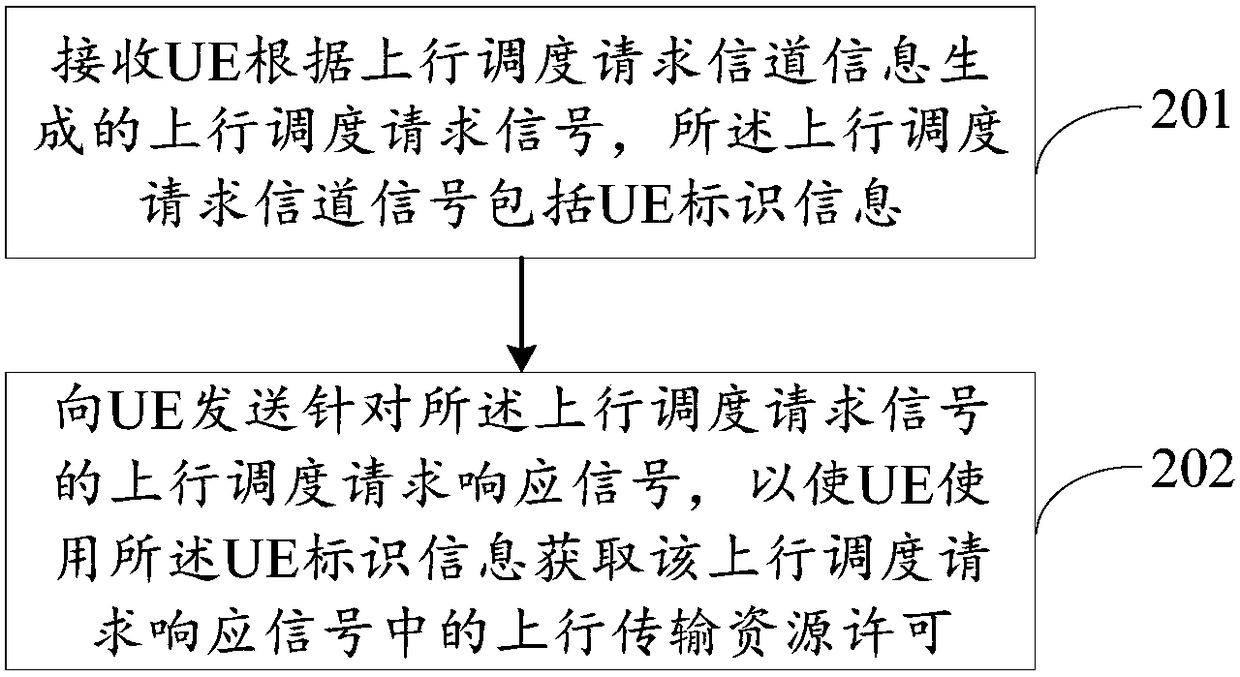Uplink dispatching request method, user equipment, and base station equipment
A technology for scheduling requests and base stations, which is applied in wireless communication, electrical components, etc., and can solve problems such as many steps, low efficiency, and impact on user experience.
- Summary
- Abstract
- Description
- Claims
- Application Information
AI Technical Summary
Problems solved by technology
Method used
Image
Examples
Embodiment 1
[0109] see Figure 5 , the following describes the process of the uplink scheduling request method in this specific embodiment and the uplink scheduling request response method in this specific embodiment cooperate with each other to complete an uplink scheduling request with two communication interaction steps. Figure 6 It is a schematic diagram of a UE side uplink scheduling request process in this embodiment.
[0110] Step 301, UE determines uplink scheduling request channel information.
[0111] The UE selects uplink scheduling request channel information for sending the uplink scheduling request from the scheduling request resources. Scheduling request resources include:
[0112] (1) A set of time-frequency resources for scheduling request signals. The scheduling request signal time-frequency resource is a time-frequency resource used for transmitting the uplink scheduling request signal. A part or all of the time-frequency resource set of the scheduling request sign...
Embodiment 2
[0163] This embodiment introduces another uplink scheduling request process with two communication interaction steps. Figure 9 It is a schematic diagram of a UE side uplink scheduling request process in this embodiment. The main difference between this embodiment and Embodiment 1 is that in Embodiment 1, the base station and UE use C-RNTI to scramble and descramble the uplink scheduling request response signal, while in this embodiment, the base station and UE use RSR-RNTI (scheduling Requesting a wireless network temporary identification, which belongs to a kind of UE identification information) performs scrambling and descrambling on the uplink scheduling request response signal. The content of the same part as that of Embodiment 1 in this embodiment will not be repeated.
[0164] Step 401, UE determines uplink scheduling request channel information.
[0165] In addition to the content described in step 301, the scheduling request resource also includes the initial_value,...
Embodiment 3
[0181] This embodiment introduces another uplink scheduling request process with two communication interaction steps. Figure 10 It is a schematic diagram of a UE side uplink scheduling request process in this embodiment. The content of the same part as that of Embodiment 1 in this embodiment will not be repeated. The main difference between this embodiment and Embodiment 1 is that in this embodiment, the uplink scheduling request response signal sent by the base station includes not only data uplink transmission resource grant, but also timing advance information estimated by the base station. Figure 11 It is a comparison between when the uplink scheduling request response signal includes timing advance information and when it does not include timing advance information. The timing advance information may be in the form of a new timing advance value TA_new, or in the form of a timing advance adjustment value TA_adjust.
[0182] When the UE detects the uplink scheduling req...
PUM
 Login to View More
Login to View More Abstract
Description
Claims
Application Information
 Login to View More
Login to View More - R&D
- Intellectual Property
- Life Sciences
- Materials
- Tech Scout
- Unparalleled Data Quality
- Higher Quality Content
- 60% Fewer Hallucinations
Browse by: Latest US Patents, China's latest patents, Technical Efficacy Thesaurus, Application Domain, Technology Topic, Popular Technical Reports.
© 2025 PatSnap. All rights reserved.Legal|Privacy policy|Modern Slavery Act Transparency Statement|Sitemap|About US| Contact US: help@patsnap.com



